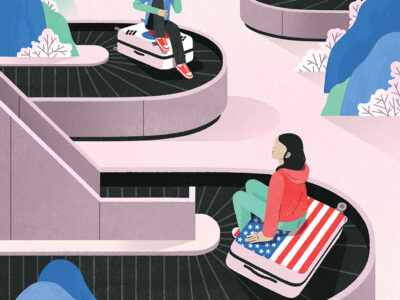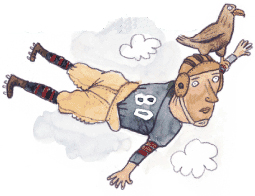
From freshman “dinks” to women’s “streaks”—and beyond. Some glimpses of campus life over the decades, as seen by the Gazette’s student columnists.
Illustrations by Regan Dunnick
1920s
From the conning tower of the good ship Pennsylvania, the more prominent aspects of campus activity are readily discernible in the drab waters of minor routine. For the most part, the first touches of spring weather, somewhat sporadically intermingled with snow and wind, are cutting disastrously into scholastic morale, and bidding fair to continue the demoralization as time goes on. The zephyrs of spring have at least brought the baseball and lacrosse players out in force, and given promise of calling the other outdoor sports into renewed activity. One by one the Freshmen are disposing of the wool toques which took the place of the black caps through the winter, and are now entered upon the final lap of the traditional race against the Sophomores. The all-important holiday in the academic calendar of the yearling class is that moment of release from all restrictions, Heyday in short.—G. Gordon Mahy Jr. C’24, March 13, 1924
The ladlers of “Punch Bowl” labeled their February product the Charleston number, just to prove that they had caught up with the times. Fifty pages are crowded with features, jokes, and illustrations relating to the newest terpsichorean effort. A series of tabloid sketches entitled, “The Charleston in History,” shows how Solomon’s 756th wife, Nero, Marie Antoinette, and John Alden interpreted the step.
The Sophomore Vigilance Committee has started an active campaign against violators of freshman regulations. The first-year men have enjoyed a period of laxity during rushing season, but the vigilantes plan to inflict drastic punishments on all violators from now on.—Robert A. Eichelberger ’26, March 12, 1926
1930s
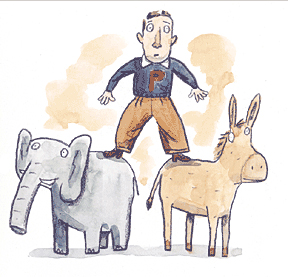
The week of December 7 marked two interesting innovations in the form of student experimentation in national and international affairs. The first of these was the group of two model nominating conventions held in Houston Hall in an attempt to forecast the stands to be taken by the two major political parties in their conventions next fall.
The Democrats proceeded to place themselves squarely in favor of prohibition repeal, reduction of the tariff, increased taxes on higher income groups, and entrance into the League of Nations. Frankin D. Roosevelt received the nomination on the second ballot. The convention was closed on the note that “the Convention favor the replacement of the Republican Party, which has so poorly managed the economic crisis, by the Democratic Party, which has already proved itself worthy of managing national affairs.”—Charles S. Snyder, January 1, 1932
Alva G. Nye C’37, end on the football team, is a well-known falconer. He was recently seen descending from a Walnut Street trolley with his falcon on his wrist, and later in the College office, where his hawk aroused great interest. We wonder whether such a bit of medievalism could be seen on any other American college campus.—E. Craig Sweeten C’37, January 1, 1937
1940s
A new school year in every sense of the word is in full swing. Not since our “dink days” had undergraduate life meant “serious business” as it does today.
Abreast with Pennsylvania’s educators and administrators, the students realize full well that we are not here to dream, to drift.
It now appears that the real graduation day, climax of the school year, will fall, uniquely, in February. Having attended the summer term, 60 percent of the seniors will bid us adieu at that time.
But traditional Commencement ceremonies and traditional everything has taken a back seat and the new way of life is one of swift and conscientious preparation for service in a fast approaching battleground, with little regard for easy enjoyment of the “good old college days” that come but once in a lifetime.—Hugh Gyllenhaal ’44, November 1942
Easily, the most pervasive question in the undergrad’s mind was whether or not the fellow who sat next to him in History was a liberal (one of those guys), a Republican (his old man must be president of U.S. Steel), a Democrat (his uncle is a ward heeler), or a Communist (a man who’d gone completely crazy). Such a curiosity for a fellow student’s politics seems natural enough, for these are curious days, these days of name-calling and labeling and categorizing by remote association. It is a slippery thing, and makes for some tricky moments, this business of attempting to judge a man’s opinions and then placing him in certain stalls—as they do with particular breeds of dogs at dog shows. This one is a Russian Wolfhound, this one is a Dachshund, this one is a Pekinese (always reclining on a purple cushion) and this one—this one is a mongrel who has no breeding.
If a student is a liberal or independent thinker he is not necessarily a Communist, and it is most certainly both naïve and careless to think of such liberal students as black-cloaked conspirators who carry under their arms bombs and in their pockets instructions from a foreign capital and make no allowance for the fact that the liberal student may be just another chap in a varsity sweater—carrying nothing more than a few ideas in his head and a sincerity of purpose in his heart.—Gilbert Sandler C’49, December 1948
1950s
Things are changing all over. Women are now allowed to use the main cafeteria in Houston Hall, and the Franklin Society, composed of the leaders of all the publications, admitted a girl this month. The Wharton School fell by the wayside this year too, and about the only all-male groups are the Houston Hall Student Board, the Daily Pennsylvanian, and the Mask and Wig Club. Members of these groups have so far been very vocal in their approval of the status quo, but the progress of coedization (as it is barbarously called) is formidable. Or at least that’s what the girls say.—Martin Griffin C’55, December 1954
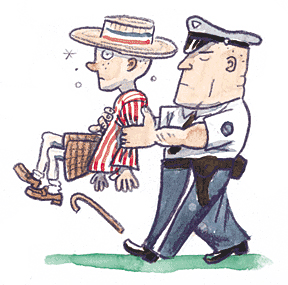
You probably read the Associated Press reports last month saying that there had been a Rowbottom on Skimmer Day, April 23. ’Twas no such thing. It was a riot.
Festivities had started early in the afternoon down at the banks of the Schuylkill, where about 7000 people watched the Pennsylvania crew outrace Princeton and Columbia. Each fraternity manned a booth where free beer was to be had, and the shore was lined with undergraduates in straw hats and Bermuda shorts, some wearing loudly striped blazers and carrying canes.
After the race, thousands of students converged on the campus.
The band at Phi Sigma Delta started performing on the corner of 39th and Spruce. There can be no doubt that the band was loud, and that the students were far from quiet in their celebrations.
By the time police had arrived—around 3 a.m.—the band had stopped playing, and the audience had begun to disperse. But as eight shiny red paddywagons and fifteen cars charged through that mass of straw-hatted humanity, the interest of the approximately 700 students in staying on the corner, which had definitely begun to flag, perked joyously up again.
The police swiftly became targets for bottles and other missiles, especially, they seemed to feel, from the Deke house. Several of them rushed into the fraternity, dashed up to the second and third floors, and broke down every door in both hallways, hauling some students out of bed to be shoved into the waiting paddywagons.—Martin Griffin C’55, June 1955
1960s
The concept of education at today’s university is different from that of the past. No longer does the student go to class to imbibe knowledge, memorize wisdom, and master a profession. The university today is a center for the expansion of knowledge. The student today is prepared to participate in this expansion.
Does this new concept of education imply that each scholar knows best how his society or community is to be run? Should the student, as he has at Berkeley, assume that administrations are, by their very nature, wrong, while students are right?
Many have concluded from the Berkeley [Free Speech Movement] that such a movement is needed at Penn. Great differences, however, exist between Penn and Berkeley on many levels.
Students wish to demonstrate to get a voice in University affairs. But the student at Pennsylvania has few complaints.
The influence of the system of student representation on important committees is not being limited, but is expanding as time goes on. Faculty-student and administrative-student relations must improve; it is fashionable to complain about them, but it is commendable to take it upon oneself to improve them.—Julie Dalton CW’66 and Irwin Arieff C’68, May 1965
1970s
In any other neighborhood, the Dirty Drug would be one of those sad old penny-candy stores that only has customers at three-thirty in the afternoon when the nearby elementary school lets out. It’s painted aquamarine, and mud-brown, with yellow and turquoise corrugated crepe paper strung erratically about. Plastic flowers are pinned up next to the most incongruous of travel posters, obtained no doubt in the early 1950s. Other relics of a time gone by lie on the counters, never bought, but never taken away: the plastic sunglasses, the picture postcards of Philadelphia, the straw pipes, and gaudy key rings.
But the daily Drug frequenters overlook all these curiosities on their way to the Tastykakes, the cigarettes, and the yogurt cartons. What they remember of the Drug is the constant motion, the vibrating soul music, the bells ringing from the pinball machines, and, of course, the sound of the cash register.
Ordering food at the counter is an exercise in survival of the fittest, since being polite with the noon-day crowd means you’ll get waited on at about four. But if you can never be sure of quick service, you can count on the never-wavering grumpiness of the girls behind the counter, who will either bark at you to speak up, or yell back that they heard you the first time, for Chrissake, when you repeat the request.
It remains the only place that could get away with serving awful food at outrageously high prices in the grimiest of atmospheres and still win the affection of every student who drops in.—Phyllis Kaniss CW’72, May 1971
March 6, 1978—My mind is fogged from lack of sleep. My body is weak from lack of food, sustained for the last four days by eight doughnuts, 12 cans of soda, several pieces of stale white bread, and one popsicle. My eyes are bleary. But what I have witnessed!
I have seen the students of the ’70s, pronounced the comatose successors of the ’60s radicals, occupy College Hall and secure 31 important concessions from the University administration.
I have listened to the “apathetic” undergraduates of an “inferior” university and heard a voice that must be heeded.
I have been part of the rebirth of student activism. And I have been part of the most intensive surge of energy to hit this campus in years. Students found themselves moderating debates, leafleting campus, orchestrating press conferences, and, even more surprising, participating.
“I can’t believe I’m doing this. We’re doing this. It’s 4:30 in the morning. I’m in College Hall. My mother is going to think I’m a Communist. I’m part of a demonstration. Incredible!” said one.—Drusie Menaker C’78, April 1978
1980s
Sister Louise could make your hair stand on end with just one glance. She was stronger than any boy in the sixth grade at Saint Pius X. She told us that she said 100 rosaries every day for our lost souls. Like everyone else, I was scared to death of her. Sister Louise definitely would not approve of photographer Robert Mapplethorpe, I thought to myself as I viewed an exhibit of his work last semester. She might appreciate his pictures of flowers, but I do not think she would like the ones of men in certain—shall we say compromising?—positions. What if Sister Louise had been standing beside me in the gallery? I can hear her raspy voice: “Kristine Marie, you are sure to perish! Hide your eyes!”
The whole experience of the exhibit made realize how much my world has changed since I left Catholic school and came to Penn. Here I was, looking at photographs of handcuffed, leather-bound men—me, the girl who spent 12 years in parochial schools and played Mary in the seventh-grade Christmas pageant. In 17 years, I had never met a non-Christian person. All of my friends and relatives were strict Catholics.
I didn’t love Mapplethorpe’s work, just like I don’t love everything about Penn. But because I came here, my naìve and narrow perspective on the world has changed drastically.
I have not solved the question of whether Mapplethorpe’s work is art or pornography, or whether it deserves government support. But at least I have been able to think about it carefully, rather than being denied access to it. —Kristine M. Conner C’89, October 1989
1990s
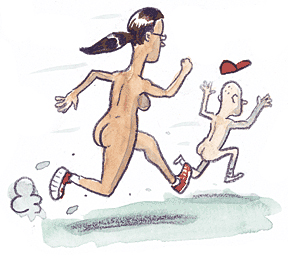
According to several participants, the notion of a women’s streak originated in the minds of members of FLASH (Facilitating Learning About Sexual Health) who had been sitting around chatting about the annual run, in which female participation had been limited to a lone, courageous woman in the spring of 1992.
One racy Racer, a Wharton senior, says she ran “just for kicks,” a sentiment echoed by other runners: “There was no deep one-upmanship. It had nothing to do with gender issues. It was more like ‘Wow, I could run naked in the Quad. That’d be a kick, why not?’ The guys do it every year; there’s gotta be something to it; they can do stupid things, so can we.” Another streaker, a College senior, agrees that “the streak was not a militant feminist movement. It was extremely social and friendly. It was not sexual or promiscuous—it was hilarious.”
One streaker describes the unexpected ideological forces she felt coursing through her veins as soon as the run was complete: “It felt great to be able to take off my clothes and do anything I want. Society has such restrictions about women baring their bodies, and we should be proud of every single bulge. I was saying, ‘I love my body, and I will bare it to the world.’”—Matthew Selman C’93, February 1993


